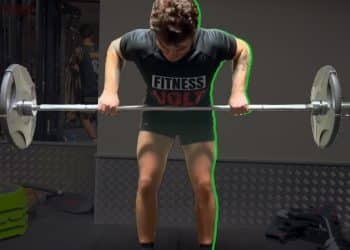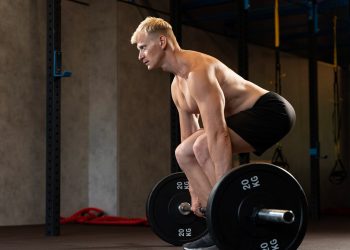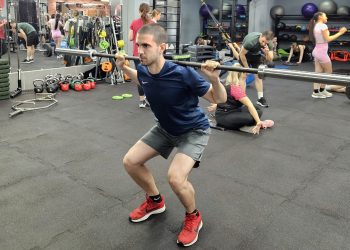The barbell deadlift is a compound exercise that works the legs, back, and core muscles. It is also one of the most badass exercises you can do in the gym. Lifting heavy weights off the floor and putting it back down is one of the most primal and gratifying things.
The barbell deadlift is also one of the three main lifts in powerlifting, the other two being the squat and bench press. The deadlift requires technical efficacy, and this exercise has many variations.
Although the deadlift looks easy, it has a steep learning curve. Beginners must spend a considerable amount of time learning the correct technique. It’s always recommended that beginners practice proper form with only the barbell or very light weight before training heavy. Advanced lifters can get the best bang for their buck by maximally loading the barbell to stimulate the target muscle groups.
In this article, we dive deep into the barbell deadlift, including the muscles worked, its benefits, the correct technique, and how to warm up to get the best bang for your buck while minimizing the risk of injury. You’ll also learn about the different types of grips used to pull a deadlift, their variations and alternatives, and popular deadlift programs. We have a lot to cover, so sit tight and read on.
What is a Barbell Deadlift?
The barbell deadlift is a hip hinge exercise that involves bending over by hinging at the hips while maintaining a straight spine. This exercise primarily targets the posterior chain, including the hamstrings, glutes, lower back, lats, and traps.
In the deadlift, you lift a loaded barbell off the floor by driving through your hips and extending your knees. Remember, the movement should mostly occur at the hip joint. Avoid excessive knee flexion and extension during this exercise. Your body will be in a straight line, from head to toe, at the top of the movement.
Level Up Your Fitness: Join our 💪 strong community in Fitness Volt Newsletter. Get daily inspiration, expert-backed workouts, nutrition tips, the latest in strength sports, and the support you need to reach your goals. Subscribe for free!
Beginners should seek a personal trainer’s help to learn the correct deadlifting technique. It will lead to maximal results and reduce your risk of injury. Many people make the mistake of lifting too heavy too soon and compromise their form, increasing their odds of getting hurt while training.
How To Do Barbell Deadlift
This is how to perform the conventional barbell deadlift with the correct form:
Step 1: Master the Setup
Put an appropriate weight on the bar. Stand upright with a hip-width stance and place the barbell against your shins. Turn out your feet slightly to get into a comfortable position. Bend over while maintaining your spine’s natural curvature and pushing your hips back. Slightly bend your knees and grab the bar with a wider than shoulder-width overhand or mixed (one hand pronated and the other supinated) grip. Your legs will be between your hands.
Pinch your shoulder blades, push out your chest to activate your lats, and maintain a flat back throughout the range of motion.
Pro Tip: Take your time to prepare for the deadlift. Rushing through the process can result in a suboptimal form and failed attempt.
Step 2: Get Ready To Pull
Your shoulders should be directly over the bar at the starting position to generate optimal force. Take a deep breath, brace your core, and tighten your grip on the bar. While lifting heavy, you must first take the slack out of the bar by slightly pulling on the bar. This will help you maintain a consistent rep tempo.
Pro Tip: Avoid ripping the bar off the floor, as it can throw you off balance. Pulling the slack out of the bar will give you a taste of the weight before you lift it off the floor. Also, consider wearing a weightlifting belt while deadlifting, as pushing against the belt can help generate thoracic pressure.
Step 3: Stand Tall
Lift the barbell off the floor while pushing through your whole foot, extending your knees, and straightening your back. Complete the lift by thrusting your hips forward when the bar passes your knees.
Avoid overextending your back at lockout, as it can strain your lower back unnecessarily. Pause and contract your glutes, quads, hamstrings, and lats at the isometric hold at the top.
Pro Tip: Unless your goal is to hoist the heaviest weight possible, you should focus on the eccentric motion of the deadlift by lowering the bar under control. Most powerlifting and Strongman competitions require the contestants to complete a controlled negative. That said, feel free to drop the bar to the floor while using one-rep max weights.
Barbell Deadlift Tips:
- Avoid performing the deadlift while wearing shoes with a significant heel-to-toe drop, as it can increase your workload and throw you off balance. Deadlift in flat shoes or barefoot.
- Keep the bar as close to your body as possible to limit lower back strain and make the exercise more efficient.
- Avoid shrugging your shoulders while performing the deadlift, as it will exhaust your traps before the primary muscles.
- Keep your head neutral throughout the range of motion. Looking forward at the starting position can strain your neck.
In This Exercise:
- Target Muscle Group: Quadriceps, Hamstrings, Glutes, Back
- Type: Strength
- Mechanics: Compound
- Equipment: Barbell
- Difficulty: Beginner
- Best Rep Range:
- Hypertrophy: 8-12
- Strength: 1-5
Watch Fitness Volt’s powerlifting coach, Enrique Santatecla, perform the barbell deadlift correctly:
Muscles Worked During a Barbell Deadlift
The deadlift is a compound (multi-joint) exercise that targets the following muscle groups:
Glutes
Since the deadlift is a hip hinge exercise, you will experience significant gluteal engagement. The glutes are the body’s biggest and strongest muscle group and do the maximum work in this exercise.
Glutes engage throughout the range of motion while performing the barbell deadlift. However, they work the hardest in lifting the barbell to lockout after the bar passes the knees during the concentric (upward) motion.
Hamstrings
Hamstrings take a close second to glutes while performing the barbell deadlift. The back of your upper legs helps you lift the barbell off the floor. They are also engaged during the eccentric (lowering) movement. It is common for folks to experience sore hamstrings after a high-volume deadlift session.
Folks with lagging hamstrings can opt for the Romanian deadlift to focus on their posterior upper legs. The Romanian deadlift (RDL) involves performing a deadlift while maintaining a slight bend in your knees. This variation restricts your range of motion, which helps focus on your hamstrings.
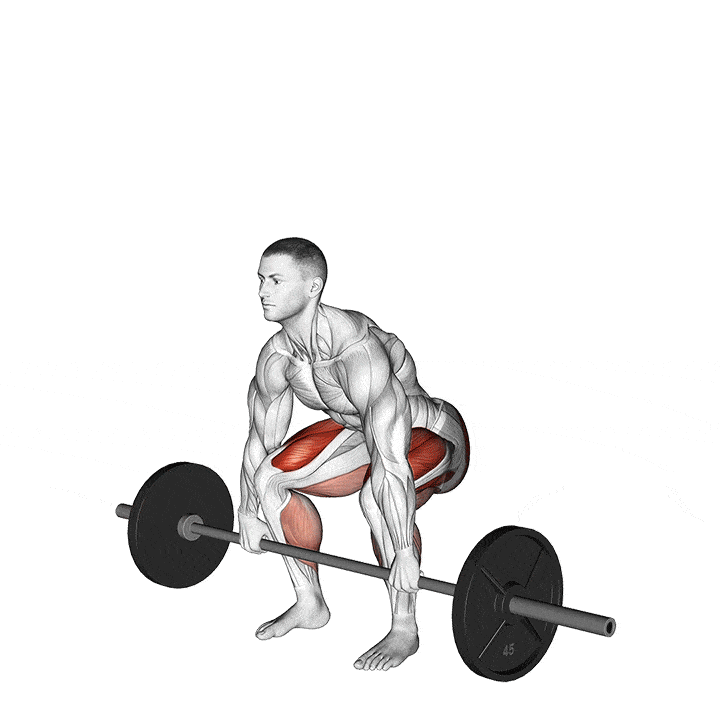
Lower Back
The deadlift requires you to pull the bar off the floor. Your lower back will be in play throughout this exercise. Although you must keep your back arched throughout the range of motion, you will still feel a considerable erector spinae recruitment.
Latissimus Dorsi
Your lats are engaged in every pulling movement; the deadlift is no different. The latissimus dorsi helps stabilize your upper body while performing the deadlift. They are under the most stress when you are in a bent-over position. The stress is relieved as you get upright. Keep your shoulder blades pulled back throughout the exercise for optimal latissimus dorsi stimulation.
Trapezius Muscle
The trapezius muscle, popularly known as the traps, is located on your back. It originates at the back of your head and neck, extends across your shoulders, and down the middle of your back. The traps are engaged as you lift the bar off the floor. You will also feel your traps at the static contraction point at the top.
Quadriceps
The role of your quads is limited while performing a deadlift. Since the quads help extend your knees, they are primarily engaged during the initial lift off the floor. However, there is close to no tension on your quads after the bar passes your knees.
Arms
Your arms are a secondary muscle group in the deadlift. As you lift heavier weights, you will experience significant forearm recruitment in the deadlift. Remember, you are as strong as your grip in the deadlift. You must work on building a strong grip to boost your deadlifting performance.
A hook grip (wrapping your fingers around your thumb) will help you hold onto the bar for longer. Conversely, you can use lifting straps while lifting heavy to eliminate your grip.
You can increase the tension on your working muscles while performing the barbell deadlift by using an extended range of motion, like in the case of a deficit deadlift. Standing on an elevated platform during the deficit deadlift, like stacked weight plates, increases the range of motion.
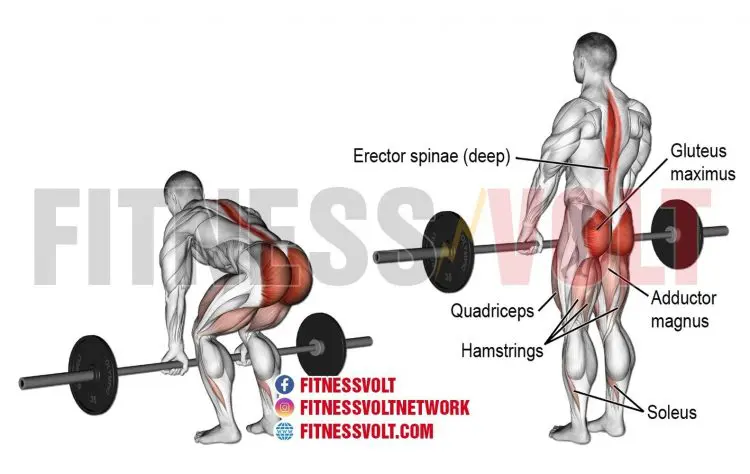
Benefits of Barbell Deadlift
Adding the barbell deadlift to your exercise arsenal entails the following advantages:
Improves Aesthetics and Overall Strength
Training for hypertrophy by performing 8-12 reps of 3-5 sets can help build muscle mass. Since the deadlift is a full-body exercise, it will help tone your overall physique. However, you will get the best results in your posterior chain, i.e., hamstrings, glutes, lower back, lats, and traps. Deadlifting will help you build wide and thick lats, improving your V-taper and adding to your physique aesthetics.
The deadlift is one of the three big lifts for a reason; it will get you stronger. You must use the progressive overload principle to make consistent gains. Increasing the training volume and intensity or reducing the rest duration between sets are effective ways of overloading your muscles.
Build a Robust Posterior Chain
Most people have a lagging posterior chain as they cannot look at these muscles directly while training them. This leads to poor mind-muscle connection and muscle recruitment, resulting in substandard gains.
The deadlift is a hip hinge movement that will work your entire posterior chain. Many people leave gains on the table by neglecting the eccentric motion and drop the barbell to the floor from the isometric hold at the top. Controlled negatives will fast-track your gains.
Improves Functionality
The deadlift is a functional movement that can improve your hand-eye coordination, core strength, and stability, boosting your performance in other compound and isolation exercises and daily functioning.
Performing a deadlift with the correct form requires decent mobility and strength. Furthermore, some variations, such as the sumo deadlift and deficit deadlift, demand greater mobility. Making the deadlift a constant in your training regimen will help improve your strength and functionality with age.
Boost Explosive Strength and Sports-Specific Performance
From time immemorial, deadlifts have been used as a strength test. Humans have evolved from lifting heavy stones to deadlifting a 1,104-pound barbell. Notably, the Atlas Stone has been the final event of the recent World Strongest Man competitions. This event requires lifting a heavy stone off the floor and putting it on an elevated platform.
You can program the deadlift into your workout according to your training objective. Speed deadlifts, pause deadlifts, and band-resisted deadlifts are a few deadlift variations that can help build explosive strength.
The deadlift is a constant in most strength sports. You cannot skip the deadlift if you have ambitions of competing in any of the strength sports, including bodybuilding, CrossFit, powerlifting, weightlifting, or Strongman.
How To Warm Up For a Barbell Deadlift
Warming up effectively before a workout can significantly improve your performance and reduce the risk of injury. Spend 5-10 minutes performing a mix of dynamic and static stretches to prepare your body for your workouts. You should also perform a few sets of light deadlifts before your working sets to establish a robust mind-muscle connection. It will also help you drill your form.
Different Barbell Deadlift Grips
The grip is one of the most overlooked aspects of deadlifting. Most people like to get to the bar and rip it off the floor as soon as possible. However, learning about different types of grips and how you can employ them can improve your performance. Here are four main ways to grip the bar during a deadlift:
Double Overhand Grip
This is arguably the most popular deadlift grip. It is especially popular amongst beginners. In fact, it is the best place to start and one of the best grips to develop grip strength. However, you must switch to the three other deadlift grips if you want to take your deadlift to the next level.
Mixed Grip
When utilizing a mixed grip, one hand grips the bar with an overhand grip while the other is in an underhand position. It is also known as the over-under grip. The mixed grip prevents the bar from rolling out your hands during the concentric motion. It is a popular grip, as most people can lift heavier with the mixed grip than the double overhand grip.
You should switch your over-under hands in every workout to ensure balanced strength and muscular development.
Hook Grip
The hook grip is a variation of the double overhand grip and is the go-to grip for Olympic weightlifters. This grip involves placing your thumb against the barbell and wrapping your fingers around it. The hook grip can help you lift heavier as it reduces grip and forearm fatigue. Plus, it prevents the bar from rolling out during explosive movements, such as clean and jerks, and snatches.
Notably, getting used to the hook grip can take some time, and it can be painful. You should tape your thumbs to prevent ripping your thumbs against the bar’s knurling. You can also use the hook grip with a mixed grip.
Lifting Straps
Although this is not technically a grip, many lifters use lifting straps to eliminate their forearm strength and focus on the target muscles. You can use lifting straps with a double overhand or mixed grip.
Common Mistakes While Performing Barbell Deadlift
You must avoid committing the following errors to make the most of the barbell deadlift and limit your risk of injury:
Excessive Lower Body Engagement
Many lifters treat the deadlift as a squat and use their legs to lift the barbell off the floor. As a rule of thumb, your upper legs should never go below parallel to the floor during a deadlift. This is a hip hinge exercise; you must use your glutes, hamstrings, and back to lift the weight.
Taller people usually have to bend their knees too much to grab the bar, which can result in a squatting motion. If you are six feet or taller, it is okay to use your legs to pull the bar off the ground. Remember, each person has unique biomechanics. You cannot copy your favorite lifter’s technique. You must tweak it and stick to what works best for you.
Lifting Your Hips Too Early
You’ve probably seen videos of people rounding their backs excessively while performing a deadlift. Most of these people raise their hips before they lift the bar off the floor, resulting in a rounded back.
You should begin the deadlift by focusing on pushing the floor away from you and extending your knees. Maintain a proud chest as you lift the bar off the floor and begin extending your hips when the bar is a few inches below your knees.
Excessive Overextension at the Top
Many lifters tend to overextend their back at the top of a deadlift. You might get away with it while lifting relatively light weights. However, your risk of lower back injury jumps through the roof while lifting close to your one-rep max. Your body should be in a straight line at the top of the movement.
Level Up Your Fitness: Join our 💪 strong community in Fitness Volt Newsletter. Get daily inspiration, expert-backed workouts, nutrition tips, the latest in strength sports, and the support you need to reach your goals. Subscribe for free!
People who keep the bar far away tend to overextend their backs at the top to compensate for the poor bar path. Keeping the bar close to your body throughout the range of motion will help you avoid the snapping point. The bar should graze your shins, narrowly miss your knees, and make contact with your body again at the bottom of your upper legs during the concentric motion.
Not Pulling the Slack Out of the Bar
Most beginners walk up to the bar and try to lift it off as soon as they get their hands around it. However, this can lead to poor form and increase your risk of injury. You must take your time to set up for the deadlift and pull the slack off the bar before you initiate the lift.
Most barbells have a slack, meaning they tend to bend a little when you lift them off the floor, especially while lifting heavy. Pulling the slack out of the bar involves bracing your core and slightly pulling on the bar. You will feel the weights engage when you do this. This will also give you a taste of the weight before you lift it off the floor.
Beginners can check for these errors by filming themselves while deadlifting. Alternatively, you could get an expert to critique your form. Learning the correct form might take a little time, but it will pay dividends in the long run.
Sumo vs. Conventional Deadlift
Ask an individual to perform a deadlift, and chances are they will stand hip-width apart or spread their legs far apart to get in a position known as the sumo stance. A sumo deadlift involves a wider-than-shoulder-width stance and grabbing the bar between your legs with a shoulder-wide grip.
Since the sumo deadlift involves a wide stance and a relatively small range of motion, this variation is popularly believed to be easier than the conventional deadlift. Sumo’s deadlift’s wide stance results in a greater vastus medialis (inner quad) and vastus lateralis (outer quad) activation than the conventional deadlift.
Notably, pulling sumo is allowed in the sanctioned powerlifting meets and is the preferred stance of most powerlifters.
The sumo and conventional deadlifts involve different mechanics and require different skills; hence recreational lifters should add both these movements to their exercise arsenal.
Choosing The Right Deadlift Setup For Your Body
There are enough deadlift variations to keep your workouts from going stale. All these variations train your muscles uniquely and involve different setups. Here are a few factors to consider if you want to determine your go-to deadlift variation:
Biomechanics
Taller lifters usually prefer the sumo deadlift as they don’t have to bend over too much. On the other hand, on average, shorter athletes favor the conventional deadlift.
Consider each deadlift variation as a skill and drill these movements to broaden your horizon. That said, it is absolutely normal if you find one variation more comfortable than the other. Make that variation a mainstay in your training and cycle through the other variations every alternate week.
Furthermore, you shouldn’t use your height as an excuse to dismiss a particular deadlift form. Although most pro Strongmen are taller than six feet, Professional Strongman competitions don’t allow pulling sumo.
Nonetheless, the 2018 World’s Strongest Man, Hafþór “The Mountain” Björnsson, holds the record for the heaviest deadlift of all time. The 6-foot-9-inch athlete pulled a 501-kilogram (1,105-pound) conventional deadlift.
Mobility
Although many people diss the sumo deadlift for being easy, the truth is most lifters lack the hip mobility to pull a sumo. That said, pulling a conventional deadlift also requires decent posterior chain mobility. It is the reason older adults have difficulty performing the conventional deadlift.
Folks that lack mobility shouldn’t shy away from the sumo deadlift or more demanding variations, such as the deficit deadlift. These exercises point toward a weakness that you must address. Add mobility drills into your fitness routine and perform more accommodating deadlift variations, such as the dumbbell, rack, and trap bar deadlift.
Target Muscle Group
You can also choose a deadlift variation to address muscle and strength imbalances. Lifters with lagging hamstrings should opt for the Romanian deadlift, whereas people with poor lower back and glute development should go for the deficit deadlift.
Equipped vs. Raw Deadlift
Tell your gym buddies you pulled 500 pounds, and they’ll probably ask if it was raw or equipped. There are two types of powerlifting meet — raw and equipped. Equipped meets allow the use of supportive equipment, such as weightlifting belts, knee wraps, bench press shirts, and squat suits. On the other hand, raw powerlifting meets shun this gear. However, most raw competitions might allow weightlifting belts, knee sleeves, and wrist wraps.
Thanks to the supportive gear, equipped lifters can lift more than athletes that lift raw. People who can deadlift 500 pounds raw can pull more weight using lifting equipment, such as lifting straps and a squat suit.
Who Should Do the Barbell Deadlift
Whether your goal is to improve your aesthetics, build muscle and strength, boost your overall functionality, or enhance your athletic performance, adding the deadlift to your fitness regimen will get you the desired results.
Strength Sports
If you are a strength sports athlete or aspiring to be one, the barbell deadlift should be a staple in your training regime. While the deadlift is a scored event in some sports, it can help build the requisite strength and muscle mass to improve your performance in others.
- Powerlifting: The deadlift is one of the three lifts in powerlifting. You cannot skip this exercise if you want to succeed in powerlifting. Follow a proven progression deadlift program to improve your pulling strength.
- Bodybuilding: Although bodybuilding shows don’t test for strength, adding the deadlift to your training regimen can help build muscle mass and improve your overall physique aesthetics. People with a lagging back should make the deadlift a constant in their training regimen to build a V-taper. Notably, you should avoid deadlifting heavy too close to a show, as it can increase your risk of injury.
- Strongman: Most Strongman competitions involve deadlifting. Plus, a single contest can involve multiple deadlifting events. Lifting an Atlas stone or a heavy sandbag off the floor requires solid deadlifting strength.
- Weightlifting: The snatch and clean and jerk are the two weightlifting events and require pulling the bar off the floor. However, because of the unique mechanics of these movements, you must perform the snatch-grip and double overhand hook grip deadlifts to train for these movements. The snatch pull is another deadlift variation that should be a part of your training regimen.
- CrossFit: As a CrossFitter, you are expected to be good at everything. You never know if your next workout of the day (WOD) requires you to pull a one-rep max (1RM) deadlift. The sumo deadlift high pull is a popular deadlift variation in CrossFit.
Even if you are not a strength sports athlete, you should add the deadlift to your exercise arsenal to improve your overall health and well-being. According to the American Council on Exercise, bend-and-lift is one of the five primary movement patterns, and practicing deadlifts regularly will help improve your physical performance in daily activities.
Who Should Avoid the Barbell Deadlift
Although the barbell deadlift is an incredibly effective exercise, it is not fit for everyone. The following group of people should exercise caution or avoid this compound lift altogether:
- People with existing back or spinal issues
- Individuals with cardiovascular or respiratory conditions
- Those dealing with injuries
- Pregnant women
You must obtain a medical clearance before starting any physical exercise routine if you are dealing with any of these issues.
How To Program Deadlifts Into Your Workout
When programming deadlifts into your workout regimen, you must consider factors such as your training goals, current fitness level, and recovery capacity. Deadlift progression plans use your 1RM as a benchmark. You don’t have to perform a max-effort deadlift to get this number. Use this one-rep max calculator to determine the max amount of weight you can pull.
Whether you are training to build muscle mass or strength, you must follow the progressive overload principle to avoid hitting a plateau. You can cycle between different deadlift variations to keep your workouts exciting. Accessory lifts will help fix muscle and strength imbalances.
Here is how to incorporate deadlifts into your workout program to build strength and muscle mass. Remember, these are general guidelines; feel free to tweak your training regimen based on your preferences.
Building Strength
Folks that want to build strength should opt for a powerlifting-style training regimen. These high-volume workouts involve performing a high number of reps and sets using weights close to your one-rep max.
One of the most popular types of strength-building deadlift programs includes performing three to six sets of deadlifts for one to five reps using 80 to 95% of your one-rep max. Strength-focused workout programs involve longer (up to five minutes) rest duration between sets to ensure optimal ATP replenishment.
Ensure that you are not resting for too long as it can lead to a drop in your core body temperature, and you might have to warm up again before you can lift heavy without increasing your risk of injury.
Building Muscle Mass
To build strength and muscle mass using the deadlift, perform three to five sets of eight to 12 reps using 70-85% of your one-rep max. Limit your rest duration between 60-120 seconds while training for strength. [1]
Furthermore, you must focus on controlling the eccentrics to get the best bang for your buck. Add deadlifting variations such as the RDL and rack pulls to ensure overall physique development.
Best Deadlift Progression Plan
The ideal deadlift progression plan for you will depend on your training experience. A good progression plan will tweak your training intensity and volume while progressively overloading your muscles.
Given below is a four-week deadlift progression plan for beginners:
Week 1
- Day One: 75% of 1RM, 5 sets of 5 reps
- Day Two: 70% of 1RM, 5 sets of 5 reps
Week 2
- Day One: 75% of 1RM, 6 sets of 5 reps
- Day Two: 70% of 1RM, 5 sets of 5 reps
Week 3
- Day One: 78% of 1RM, 5 sets of 5 reps
- Day Two: 72% of 1RM, 4 sets of 5 reps
Week 4
- Day One: 80% of 1RM, 5 sets of 4 reps
- Day Two: 75% of 1RM, 5 sets of 5 reps
The first four weeks of a beginner deadlift program are generally known as the ‘hypertrophy block.’ It is followed by four weeks of ‘strength block’ and then four weeks of ‘peak block.’
Popular Deadlift Programs
Following a certain set of principles will help you build a bigger deadlift. Avoid reinventing the wheel and follow a proven training program. Here are some of the most popular deadlift programs to help you pull ungodly weights:
For Beginners: Strong Lifts 5×5
The Strong Lifts 5×5 program will help you build a solid foundation, add strength and muscle mass, and lose fat. This program includes five exercises (squat, bench press, deadlift, barbell row, overhead press) and involves alternating between two workouts three days a week.
For Intermediate Lifters: The Texas Method
The Texas Method consists of three weekly workouts designed to help you lift heavier with every passing week. Mondays in this training program are high-volume days, Wednesdays are light days to allow your body time for recovery, and Fridays are heavy high-intensity days where you’ll be pushing your five-rep max.
For Advanced Lifters: Madcow 5×5
Madcow 5×5 takes Strong Lifts 5×5 to the next level and is great for setting new PRs and breaking through plateaus. This program is based on pyramid training and involves lifting heavier in every successive workout. Madcow 5×5 aims to add 5 pounds to your deadlift every week.
Next Read: 6 Powerlifting Strength Training Programs (Beginner to Advanced)
Variations of Barbell Deadlift
Performing the same exercise every week can get very boring, very fat. Variations can help rekindle your love for the deadlift. Try these barbell deadlift variations in your next workout:
Dumbbell Deadlift
Depending on your mechanics, the dumbbell deadlift can be a friend or foe. Beginners usually prefer the dumbbell variation over the conventional barbell deadlift, as it puts their arms and shoulders in a more comfortable position. On the other hand, dumbbell deadlifts involve a greater range of motion, which can be a problem for lifters with limited mobility.
Rack Pull
Rack pulls, also known as block deadlifts, allow you to alter your range of motion and tweak the exercise’s resistance profile. It can help you break through plateaus and overcome your sticking points.
Most lifters usually set the safety pins below their knee level. Focus on keeping your scapula pulled back and down during this exercise and maintaining the natural arch in your back. Also, controlling the eccentrics will add pounds to your deadlifts over time.
Snatch-Grip Deadlift
The snatch-grip deadlift is a staple in an Olympic weightlifter’s training regimen. This deadlift variation involves a wide snatch-like grip. Because of this exercise’s setup, your quads will be almost parallel to the floor at the starting point, resulting in greater hamstrings, glutes, and lower back engagement.
Alternatives of Barbell Deadlift
There will be days when you’ll not want to lift a heavy bar off the floor. Here are three barbell deadlift alternatives for these days:
Barbell Hip Thrust
The barbell hip thrust is an isolation exercise that allows you to target the biggest and strongest muscle in your body — the glutes. Stronger glutes can result in bigger deadlifts and squats and improve your overall functionality. Perform the barbell hip thrust unilaterally to fix strength and muscle imbalances.
Kettlebell Swing
If you’re trying to build explosive strength, you must add the kettlebell swing to your workout routine. This compound movement will help you build a stronger posterior chain, tone and strengthen your butt, and burn fat. Focus on driving through your hips during the concentric (upward) motion to maximize glute stimulation.
Single-Leg RDL
The single-leg Romanian deadlift is an incredibly effective exercise to build a stronger posterior chain, improve your core strength and balance, and fix muscle and strength imbalances. Focus on the exercise mechanics and contracting your muscles with each rep instead of lifting heavy. The single-leg RDL will translate to a more stable conventional barbell deadlift.
Frequently Asked Questions
Can I deadlift every day?
Technically, yes, but if you are trying to build a bigger deadlift, you should give your body enough time to rest and recover between workouts. Lifters training for strength or muscle gains should wait at least 48 hours before training the same muscle group again.
How can I boost my deadlift numbers quickly?
The fastest (and safest) way to boost your deadlift is to follow a suitable progression and workout plan. Pick a deadlift workout program that fits your experience level. Punching above your weight can increase your risk of injury.
Can I deadlift with a stiff back?
A stiff back is a sign that your body needs time to recover. Avoid training with a stiff back to reduce your risk of overtraining and injury. Also, you should cut short your deadlifting session if you experience acute lower back stiffness.
Wrapping Up
The barbell deadlift is an incredibly effective compound exercise for building strength and muscle mass and improving overall functionality. Beginners should focus on mastering the exercise mechanics before chasing big weights.
Serious lifters should follow the deadlift programs mentioned in this article to grow their pulling strength exponentially. Use the deadlift variations and alternatives to keep your workouts interesting. Best of luck!
References
- Krzysztofik M, Wilk M, Wojdała G, Gołaś A. Maximizing Muscle Hypertrophy: A Systematic Review of Advanced Resistance Training Techniques and Methods. Int J Environ Res Public Health. 2019 Dec 4;16(24):4897. doi: 10.3390/ijerph16244897. PMID: 31817252; PMCID: PMC6950543.
Interested in measuring your progress? Check out our strength standards for Bench Press, Rack Pull, Clean, and more.





